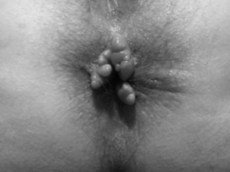223 Crohn’s disease
Instruction
These patients have chronic diarrhoea.
Examine this patient’s face (Patient 3).
Salient features
History
Advanced-level questions
How would you investigate a patient with Crohn’s disease?
• FBC, ESR, C-reactive protein, liver function tests, serum iron, vitamin B12, red cell folate
• Sigmoidoscopy and rectal biopsy
• Capsule endoscopy to determine extent of small bowel involvement
• Barium enema (rarely used): ‘Cobblestone’ pattern, ‘rose-thorn’ ulcers, colon strictures with rectal sparing
• Colonscopy to determine extent of disease (preferred to barium enema)
• MRI of pelvis to determine pelvic involvement and fistulae
• MRI of small bowel to determine disease activity and strictures.
How would you treat Crohn’s disease?
• Sulfasalazine or rectal steroids for colonic disease
• Oral steroids for small bowel disease
• Metronidazole for perianal disease and fistulae
• 6-Mercaptopurine and azathioprine may be useful in severe cases
• Tumour necrosis factor-α inhibitors such as adalimumab and infliximab. A recent study reported that infliximab plus azathioprine or infliximab monotherapy was more likely to result in corticosteroid-free clinical remission than azathioprine monotherapy (N Eng J Med 2010;362:1383–95)
• Surgery is reserved for intestinal fistulae and intestinal obstruction that does not respond to medical management. Proctocolectomy and ileostomy is the standard operation. (Note: Ileorectal anastomosis or ileoanal anastomosis should be avoided in Crohn’s disease.)
• Empirical clinical experience suggests that antibiotics are useful in the treatment of subgroups of patients. Metronidazole can be effective in those who have perianal fistulae. Ciprofloxacin and clarithromycin have been advocated as alternatives to metronidazole. The effectiveness of non-specific antibiotics and experimental evidence of the central role of the luminal flora for the development of disease has led to the use of probiotic bacteria (the administration of ‘healthy’ bacteria). Patients with pouchitis or active Crohn’s disease who were treated with a mixture of commensal bacteria had a positive therapeutic response. Local treatment with interleukin-10-secreting Lactococcus lactis is undergoing clinical evaluation.









